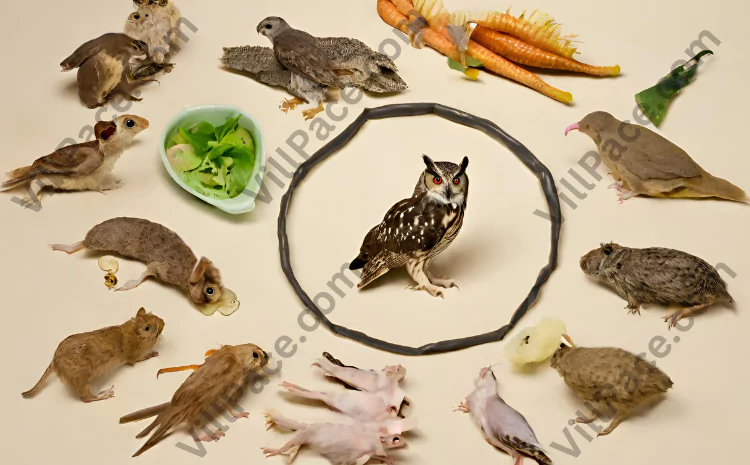Owls have captured our imagination for ages with their mysterious ways and nocturnal habits. But one question still puzzles many – what do these mesmerizing birds eat? Read on as we shed light on the eating habits of various owl species.
Key Takeaways
- Owls are carnivorous birds of prey that primarily hunt small mammals like mice, rabbits, voles and shrews.
- They also eat insects, fish, reptiles, amphibians and even other birds.
- The diet of an owl depends on its species and habitat. Larger owls eat larger prey.
- Owls swallow their prey whole and regurgitate indigestible parts like fur, feathers and bones in the form of pellets.
What Kind of Food Do Owls Eat?
Owls are carnivorous birds belonging to the order Strigiformes. They depend on a diet of meat and predominantly hunt small mammals like mice, rabbits, voles and shrews that are abundant at night.
Insects like beetles, grasshoppers, moths, crickets and caterpillars also form a part of an owl’s diet, more so for smaller owl species. Apart from this, owls also prey on:
- Reptiles and amphibians: lizards, snakes, frogs, salamanders
- Fish
- Birds: songbirds, other small owl species
- Earthworms
So in essence, owls are opportunistic hunters that eat whatever small animals are available as per their habitat.
| Small Mammals | Insects | Reptiles/Amphibians |
|---|---|---|
| Mice | Beetles | Lizards |
| Voles | Grasshoppers | Frogs |
| Rabbits | Crickets | Salamanders |
| Shrews | Caterpillars | Snakes |
Factors That Determine an Owl’s Diet
Several factors account for what owls eat. The most important ones are:
Size of the Owl
The smaller the owl, the smaller its prey. For instance, a tiny Elf Owl largely feeds on insects whereas the large Great Horned Owl hunts rabbits and skunks.
Habitat
Forest-dwelling owls like the Barred Owl eat mammals and birds found in the woods. Grassland owls like the Short-eared Owl primarily feed on mice, voles and shrews.
Unique Adaptations for Hunting
Over millions of years, different owl species have developed specialized adaptations to succeed as nocturnal hunters:
- Sharp talons to seize prey
- Curved beaks to tear flesh
- Extremely sensitive hearing to locate prey
- Almost soundless flight to stealthily swoop down
- Excellent night vision
These features allow owls to expertly hunt in darkness. An owl can even snatch a mouse scurrying underneath snow by pinpointing its prey through sound!
Digestion Regurgitation Process
While owls have no trouble catching prey with their razor-sharp talons, they swallow their food whole! And that too almost instantly thanks to their expandable throat pouch.
The digestive juices dissolve the flesh, but not the fur and bones. Around 10 hours after eating, owls regurgitate the indigestible parts in the form of owl pellets – dark-colored compact masses of fur, tiny bones, claws, beaks, and exoskeletons of insects.
Analysis of these owl pellets provides great insight into an owl’s diet and their ecosystem. Quite like unpacking treasures from an owl’s food diary!
Examples: Food of Different Owl Species
Now that we’ve explored some broad food habits of owls, let’s take a look at the diet specifics of a few common owl species:
Barn Owl
- A medium-sized owl with heart-shaped face
- Hunts over grasslands and fields
- Eats mainly mice, voles, rats, pocket gophers
- Also preys on small birds like sparrows
Barred Owl
- A large forest owl native to North America
- Preys on mice, voles, wood rats
- Also eats frogs, fish, insects
- Sometimes hunts rabbits and squirrels
Great Horned Owl
- One of the most common large owls found across Americas
- A powerful and adaptable predator
- Hunts rabbits, hares jackrabbits, rats
- Also eats many bird species including ducks and raptors
- Has been known to prey on skunks, cats, bats, and other owls
In Closing
So that covers the answer to “what do owls eat”. To summarize, most owls are opportunistic hunters that prey on whatever small mammals and other animals are readily available in their habitat and can be successfully hunted. The diet varies by owl species depending on its size and ecosystem. Hopefully, this post has shed light on the food habits of these majestic raptors of the night!

Mark Thompson, a seasoned pest controller, is renowned for his expertise in keeping homes and businesses free from unwanted intruders. With a passion for environmental sustainability and a deep understanding of pest behavior, Mark has become a trusted authority in the industry.
